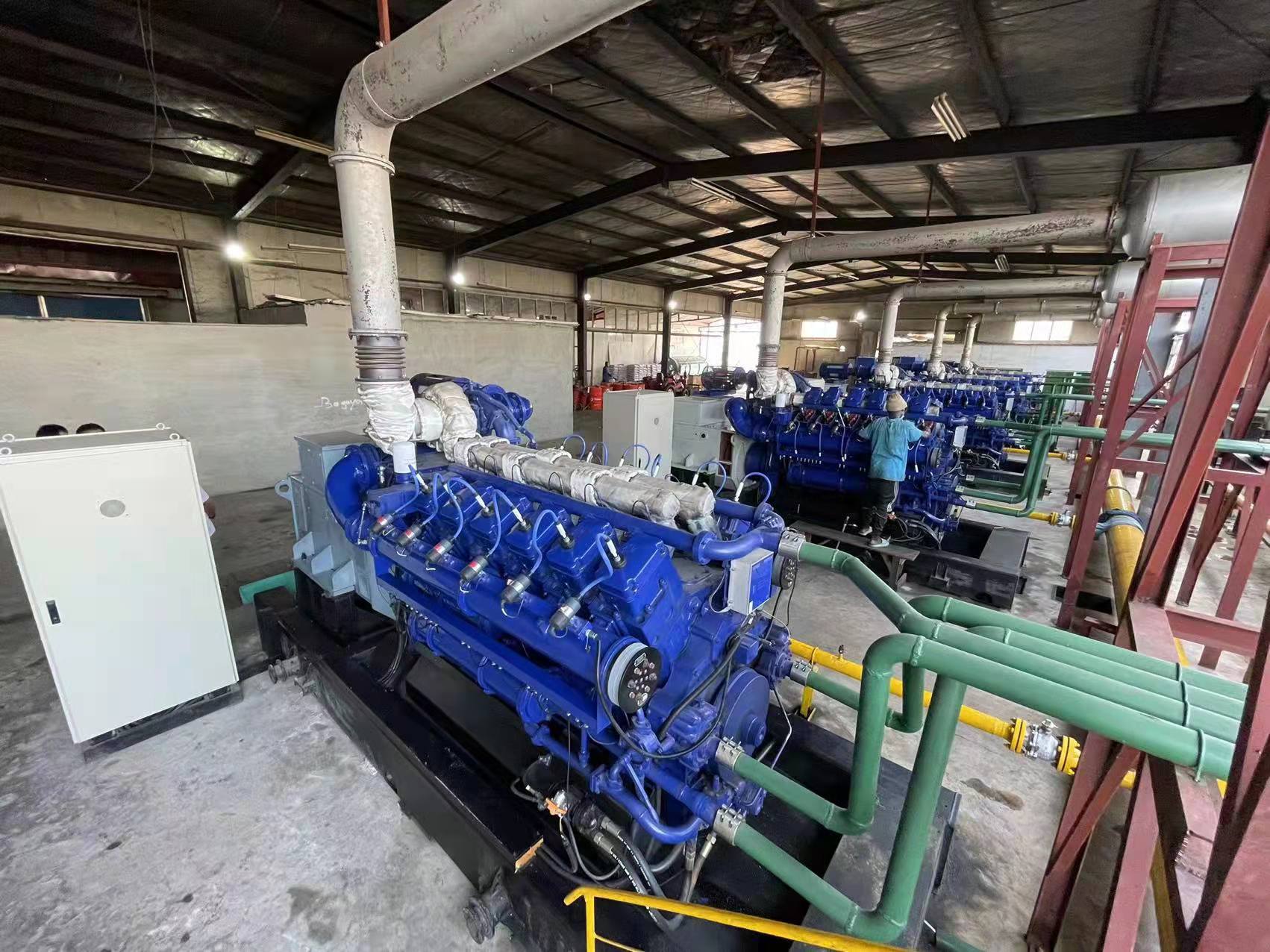生物质气化是指将生物质燃料转化为可燃性气体的热化学过程。在这个过程中水蒸气游离氧或结合氧与燃料中的碳进行热化学反应,生成可燃气体。 生物质气化过程比较复杂,气化反应条件也各不相同但所有气化反应的过程基本都包括生物质的干燥热解氧化和还原反应过程。
Biomass gasification refers to the thermochemical process of converting biomass fuel into combustible gas. During this process, water vapor undergoes a thermochemical reaction between free oxygen or combined oxygen and carbon in the fuel, generating combustible gases& nbsp; The biomass gasification process is relatively complex, and the gasification reaction conditions are also different. However, all gasification reactions basically include the drying, pyrolysis, oxidation, and reduction reactions of biomass.
下吸式固定床气化炉,其特征是气体和生物质的运动方向相同,所以又称顺气式气化炉。下吸式固定床气化炉的热解产物必须通过制热的氧化层,因此挥发分中的焦油可以得到充分的分解,燃气中的焦油含量大大低于上吸式固定床气化炉。它适用于相对干燥的块状物料(含水率低于30%),以及含有少量粗糙颗粒的混合物料,且运行方便可靠。由于下吸式固定床气化炉的燃气中焦油含量较低,特别适用于小型发电系统。
The downdraft fixed bed gasifier is characterized by the same movement direction of gas and biomass, so it is also known as a downstream gasifier. The pyrolysis products of the downdraft fixed bed gasifier must pass through the heated oxide layer, so the tar in the volatile matter can be fully decomposed, and the tar content in the gas is much lower than that of the updraft fixed bed gasifier. It is suitable for relatively dry block materials (with a moisture content below 30%), as well as mixed materials containing a small amount of rough particles, and is easy and reliable to operate. Due to the low tar content in the gas of the downdraft fixed bed gasifier, it is particularly suitable for small power generation systems.
干燥层
Drying layer
气化炉上层为干燥区,从上面加入的物料直接进入到干燥区,物料在这里同下面三个反应区生成的热气体产物进行换热,使原料中的水分蒸发出去,该层温度为 200~300℃。干燥层的产物为干物料和水蒸气,水蒸气随着下面的三个反应区的产热排出气化炉,而干物料则落入热解区。
The upper layer of the gasifier is a drying zone, where the materials added directly enter the drying zone. Here, the materials exchange heat with the hot gas products generated in the three reaction zones below, allowing the moisture in the raw materials to evaporate. The temperature of this layer is; 200~300℃。 The products of the drying layer are dry materials and water vapor, which are discharged from the gasifier with the heat generation in the three reaction zones below, while the dry materials fall into the pyrolysis zone.

热解层
pyrolytic layer
生物干物料向下运行进入热解层,同时将生物质加热,当生物质受热后发生热解反应。通过热解反应生物质中大部分的挥发分从固体中分离出去,在500~600℃时基本完成,剩下木炭。热解区的主要产物为炭氢气水蒸气一氧化碳二氧化碳甲烷焦油及其他烃类物质等。
The biological dry material moves downwards into the pyrolysis layer, while heating the biomass. When the biomass is heated, a pyrolysis reaction occurs. Most of the volatile components in biomass are separated from the solid through pyrolysis reaction, and are basically completed at 500-600 ℃, leaving charcoal. The main products of the pyrolysis zone are carbon, hydrogen, water vapor, carbon monoxide, carbon dioxide, methane, tar, and other hydrocarbon substances.
氧化层
oxide layer
热解的剩余木炭与被的空气发生剧烈反应,释放大量热量。由于是限氧燃烧,氧气的供给是不充分的,因而不完全燃烧反应同时发生,生成一氧化碳,同时也放热量。在氧化区,温度可达1000℃,反应方程式为:
The remaining charcoal from pyrolysis reacts violently with the air, releasing a large amount of heat. Due to limited oxygen combustion, the supply of oxygen is insufficient, resulting in incomplete combustion reactions occurring simultaneously, generating carbon monoxide and also releasing heat. In the oxidation zone, the temperature can reach 1000 ℃, and the reaction equation is:
△H △H=408.8千焦
△H △ H=408.8 kJ
在氧化区进行的均为燃烧反应,并放出热量,也正是这部分反应热为还原区的还原反应物料的裂解和干燥,提供了热源。在氧化区中生成的热气体(一氧化碳和二氧化碳)进入气化炉的还原区,灰分落入下部的灰室中。
The reactions carried out in the oxidation zone are all combustion reactions and release heat, which provides a heat source for the cracking and drying of the reduction reaction materials in the reduction zone. The hot gases generated in the oxidation zone (carbon monoxide and carbon dioxide) enter the reduction zone of the gasifier, and the ash falls into the lower ash chamber.
还原层
Restoring layer
在还原区已没有氧气存在,在氧化反应中生成的二氧化碳在这里同炭及水蒸气发生还原反应,生成一氧化碳(CO)和氢气(H2)。由于还原反应是吸热反应,还原区的温度也相应降低,约为600~800℃。还原区的主要产物为一氧化碳(CO)二氧化碳(CO2)和氢气(H2)。
There is no oxygen present in the reduction zone, and the carbon dioxide generated during the oxidation reaction undergoes a reduction reaction with carbon and water vapor, producing carbon monoxide (CO) and hydrogen gas (H2). Since the reduction reaction is a endothermic reaction, the temperature of the reduction zone also decreases correspondingly, about 600~800 ℃. The main products of the reduction zone are carbon monoxide (CO), carbon dioxide (CO2), and hydrogen gas (H2).
气化实际上总是兼有燃料的干燥裂解过程。在实际的操作过程中,上述四个区域没有明确的边界,是相互渗透和交错的。所以在气化炉出口,产出气体成分主要为一氧化碳(CO),二氧化碳(CO2)氢气(H2)甲烷(CH4)焦油及少量共他烃类,还有水蒸气及少量灰分。
Gasification actually always involves the drying and cracking process of fuel. In the actual operation process, the four regions mentioned above do not have clear boundaries and are mutually penetrating and intersecting. So at the outlet of the gasifier, the main gas components produced are carbon monoxide (CO), carbon dioxide (CO2), hydrogen (H2), methane (CH4), tar, and a small amount of co hydrocarbons, as well as water vapor and a small amount of ash.
 联系 - 热线
联系 - 热线

 联系 - 热线
联系 - 热线


